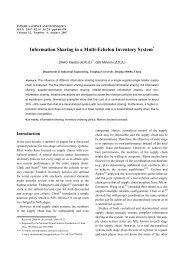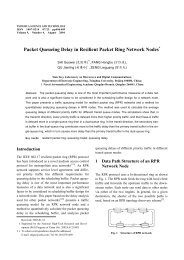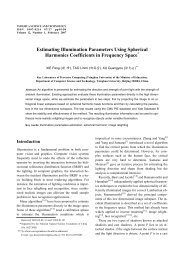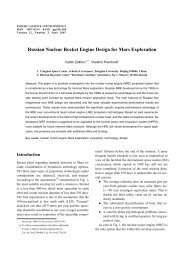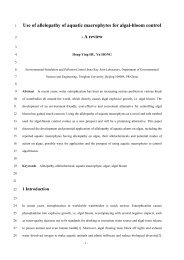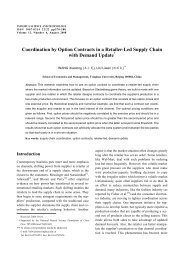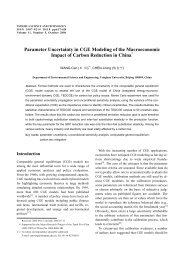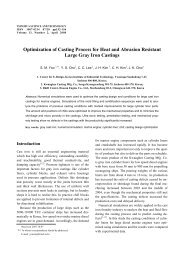Chilling Tendency and Chill of Cast Iron
Chilling Tendency and Chill of Cast Iron
Chilling Tendency and Chill of Cast Iron
Create successful ePaper yourself
Turn your PDF publications into a flip-book with our unique Google optimized e-Paper software.
E. Fraś et al:<strong><strong>Chill</strong>ing</strong> <strong>Tendency</strong> <strong>and</strong> <strong>Chill</strong> <strong>of</strong> <strong>Cast</strong> <strong>Iron</strong> 181<br />
graphite nodules were characterized by Raleigh distributions<br />
[14] so the volumetric nodule count, N, could<br />
be related to the planar nodule count, NnF, using the<br />
Wiencek equation [15]<br />
N<br />
3<br />
NF<br />
= (16)<br />
f<br />
where fgr is the volume fraction <strong>of</strong> graphite at room<br />
temperature, fgr≈0.11-0.14.<br />
3 Results <strong>and</strong> Discussion<br />
3.1 Flake graphite cast iron<br />
The experimentally determined ∆Tm <strong>and</strong> N were used<br />
with [16,17]<br />
Case<br />
No.<br />
td<br />
s<br />
gr<br />
⎛ b ⎞<br />
N = N exp −<br />
⎜<br />
⎝ ∆Tm<br />
⎠ ⎟<br />
∆Tsc/℃<br />
(17)<br />
Table 2 Experimental <strong>and</strong> calculated results<br />
Nucleation coefficients<br />
Ns/cm −3<br />
I/1 — 35.2 1.6×10 5<br />
I/2 0.06 51.1 6.1×10 6<br />
I/3 0.20 52.3 6.8×10 6<br />
I/4 0.40 52.3 4.4×10 6<br />
I/5 0.60 51.5 5.4×10 6<br />
I/6 0.80 53.0 1.3×10 6<br />
I/7 1.00 52.9 8.4×10 5<br />
to determine the nucleation coefficients Ns <strong>and</strong> b by<br />
statistical methods (shown in Table 2). In all cases, the<br />
correlation coefficients were high (0.86-0.99) so the re-<br />
lationship between N <strong>and</strong> ∆Tm described by Eq. (17) is<br />
in good agreement with the experimental evidence.<br />
The nucleation coefficients Ns <strong>and</strong> b can be related to a<br />
dimensionless time t = t/ t , where t is the time calcu-<br />
d<br />
r<br />
lated from the instant in which the inoculant was intro-<br />
duced into the melt <strong>and</strong> tr<br />
is the time when the observed<br />
changes in the cell count were negligible (tr=25 min).<br />
b/℃<br />
Note: Mean temperature (just after pouring) <strong>of</strong> wedge Ti ≈ 1270℃, n=0.877<br />
The chilling tendency, CT, <strong>and</strong> the total width <strong>of</strong> the<br />
chill, W, can be estimated from Eqs. (2) <strong>and</strong> (4) as<br />
functions <strong>of</strong> the chemical composition <strong>of</strong> the cast iron,<br />
the nucleation coefficients, the mean initial temperature<br />
<strong>of</strong> wedge, Ti, the wedge size coefficients n in the<br />
note <strong>of</strong> Table 2, <strong>and</strong> thermophysical data in Table 1.<br />
The results in Table 2 show that the theoretical predictions<br />
agree well with the experimental results.<br />
3.2 Ductile cast iron<br />
The experimental data for ductile iron ∆Tm <strong>and</strong> N can<br />
be used with Eq. (17) to calcutate the melt nucleation<br />
coefficients, Ns <strong>and</strong> b, listed in Table 3. The correlation<br />
coefficients for all the melts are quite high (0.84-0.98).<br />
It is not surprising that the nucleation coefficients Ns<br />
<strong>and</strong> b for each melt differ. However, in each case, N<br />
( )<br />
−3<br />
N = 6.5 −0.8 t − 5.3 t × 10 cm ,<br />
2 6<br />
s d d<br />
b= (96.9 + 122.6 t − 59.2 t ) ℃ (18)<br />
Measured<br />
total width <strong>of</strong><br />
chill (mm)<br />
d<br />
Calculated<br />
total width <strong>of</strong><br />
chill (mm)<br />
2<br />
d<br />
CT/( s 1/2 ·℃ –1/3 )<br />
76.8 7.9 8.8 1.10<br />
104 3.3 3.6 0.43<br />
119 3.6 3.6 0.44<br />
135 4.0 4.1 0.50<br />
154 4.5 5.4 0.65<br />
152 4.8 5.2 0.63<br />
162 5.5 5.8 0.71<br />
<strong>and</strong> ∆Tm are related as in Eq. (17), thus confirming that<br />
the theory is in good agreement with the experimental<br />
results.<br />
Table 3 Nucleation coefficients, temperature ranges, ∆T sc,<br />
<strong>and</strong> chilling tendencies, CT, for graphite<br />
Melt<br />
Nucleation coefficients<br />
No. Ns/cm −3<br />
1 4.13×10 7<br />
2 2.95×10 8<br />
3 5.69×10 7<br />
4 4.01×10 7<br />
5 4.24×10 7<br />
6 5.16×10 7<br />
7 4.85×10 7<br />
b/℃<br />
Note: CT is calculated by Eq. (7).<br />
∆Tsc/ ℃ CT/(s 1/2 ·℃ –1/3 )<br />
58 59.7 1.14<br />
100 51.9 0.90<br />
60 56.9 1.09<br />
42 58.9 1.07<br />
20 61.2 0.90<br />
20 60.9 0.84<br />
43 59.2 1.00



